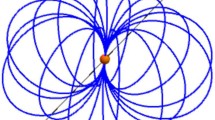Abstract
I HAVE recently pointed out1 that a vibrating neutron star, which is expected to be formed as a remnant of the explosion of a Type I supernova, may store up to 1051 or 1052 ergs as mechanical energy of vibration. This energy may be dissipated by various non-thermal mechanisms. If a magnetic field is embedded in the neutron star, then the vibrations will produce hydromagnetic waves which travel along the field lines, and these will be capable of accelerating charged particles to high energies by transit2 and stochastic3 acceleration processes. There is a possibility that the synchrotron radiation of X-rays from the Crab Nebula results from acceleration processes of this type, where the accelerated electrons have been able to diffuse into the outer expanding envelope. Such a diffusion is rendered easier if there should be a corona produced around the neutron star, which expands to form a stellar wind, thus drawing radially outward the magnetic lines of force. Such coronal heating may arise from shocks produced by the vibrations in the atmosphere1 or by electromagnetic interaction, between the magnetic field and the surrounding plasma (Manley, O., private communication).
Similar content being viewed by others
References
Cameron, A. G. W., Nature, 205, 787 (1965).
Shen, C. S., Astrophys. J., 141, 1091 (1965).
Sturrock, P. A. (in preparation).
Waddington, C. J., in Progress in Nuclear Physics, 8, 3 (Pergamon Press, Oxford, 1960).
Waddington, C. J., Proc. Intern. Conf. Cosmic Rays and the Earth Storm, J. Phys. Soc. (Japan), 17, Supp. A III, 63 (1962).
O'Dell, F. W., Shapiro, M. M., and Stiller, B., Proc. Intern. Conf. Cosmic Rays and the Earth Storm, J. Phys. Soc. (Japan), 17, Supp. A III, 23 (1962).
Cameron, A. G. W., “Nuclear Astriophysics”, notes of lectures at Yale University (1963).
Gaustad, J. E., Astrophys. J., 139, 406 (1964).
Cameron, A. G. W., Astrophys. J., 130, 429 (1959).
Chiu, H. Y., in Stellar Evolution, edit. by Stein, R. F., and Cameron, A. G. W. (Plenum Press, in the press, 1965).
Chiu, H. Y., in the proceedings of the Conference on Nucleosynthesis (to be published).
Colgate, S. A., and White, R. H. (in preparation).
Gilbert, A., Truran, J. W., and Cameron, A. G. W. (in preparation).
Chiu, H. Y., and Salpeter, E. E., Phys. Rev. Letters, 12, 412 (1964).
Colgate, S. A., and Johnson, M. H., Phys. Rev. Letters, 5, 235 (1960).
Author information
Authors and Affiliations
Rights and permissions
About this article
Cite this article
CAMERON, A. Cosmic Ray Production by Vibrating Neutron Stars. Nature 206, 1342–1343 (1965). https://doi.org/10.1038/2061342a0
Issue Date:
DOI: https://doi.org/10.1038/2061342a0
- Springer Nature Limited
This article is cited by
-
Surface composition of magnetic neutron stars
Astrophysics and Space Science (1972)
-
Coherent mechanisms of radio emission and magnetic models of pulsars
Astrophysics and Space Science (1969)
-
Nucleosynthesis in neutron star atmospheres
Astrophysics and Space Science (1969)
-
Hydrogen and helium abundances in neutron-star atmospheres
Astrophysics and Space Science (1968)
-
Rotation of Neutron Stars
Nature (1966)





